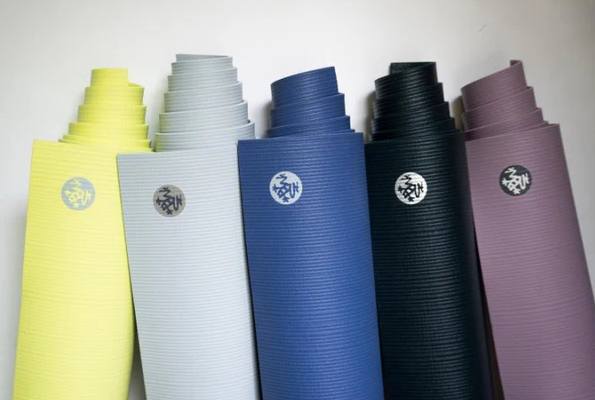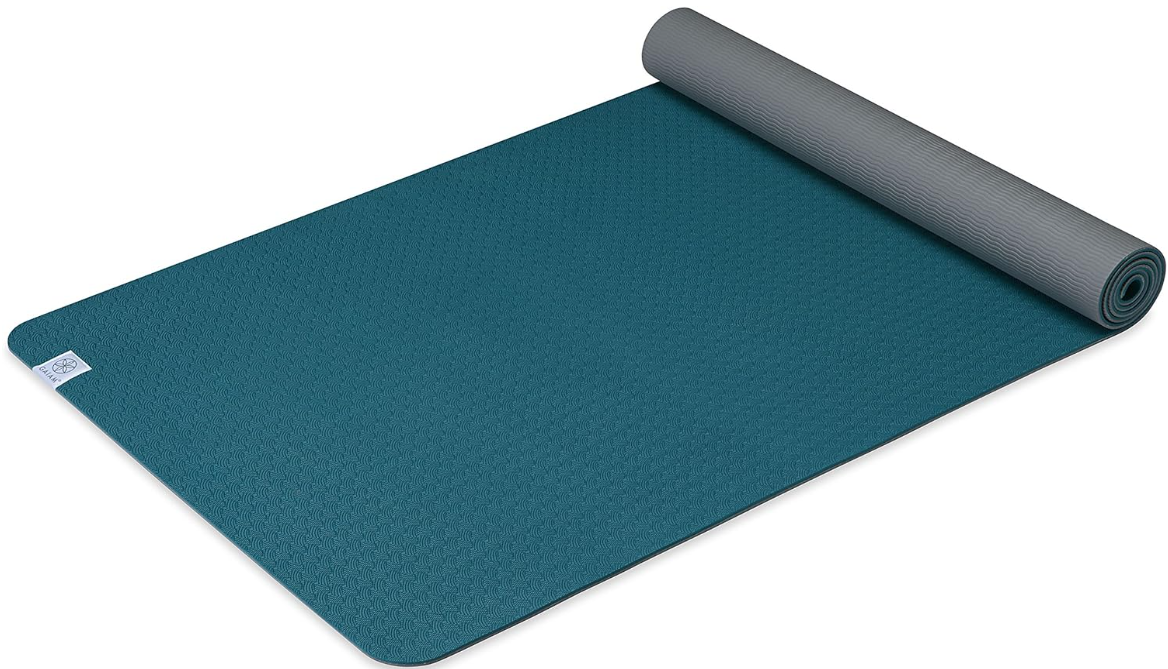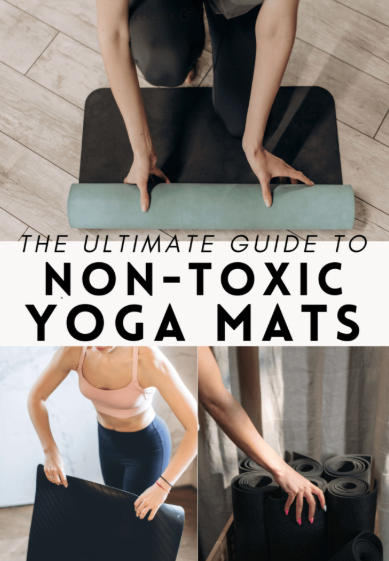From my experience, finding a safe yoga mat is key for a healthy practice. A lot of mats are labeled “eco-friendly,” but how can we be sure? In this guide, I’ll walk you through non-toxic yoga mats. We will focus on safe materials to help you make a good choice.

Why Non-Toxic Materials Matter in Yoga Practice
Safe mats protect you from harmful chemicals. These chemicals can irritate your skin or create long-term health problems. I’ve noticed many standard mats contain PVC. This material can release gasses called volatile organic compounds (VOCs). Choosing a non-toxic option is a great decision for your well-being. It also helps the environment.
Common Concerns: VOCs, PVC, Phthalates, Heavy Metals
Many yoga mats made from PVC can release harmful VOCs. This may lead to breathing trouble and skin allergies. Mats with phthalates and heavy metals present serious health risks. It is very important to choose materials without these toxic substances.
What to Look for in a Safe Yoga Mat
I suggest you consider these points when selecting a non-toxic yoga mat:
– Materials: I recommend TPE, natural rubber, cork, and organic cotton. These are excellent choices.
– Key Certifications: Look for certifications like OEKO-TEX, SGS, REACH, and GOTS. These labels help confirm the product is safe.
– Ingredients to Avoid: I personally stay away from PVC, latex (if you have allergies), glues, and synthetic dyes. This helps limit your contact with harmful chemicals.
Now you understand what to look for. You can pick a safe and non-toxic yoga mat that supports your practice and health.
My Top Picks for Non-Toxic Yoga Mats
Here, I’ll share my favorite non-toxic yoga mats. I chose them because they are safe and perform well. Each mat offers great quality and is good for the planet.
Manduka GRP Adapt or eKO Series

Material: Made from natural rubber that is not harvested from the Amazon.
Features: Contains no PVC, EVA, or harmful foaming agents.
Best For: I recommend this for hot yoga and intense workouts.
Pros: It gives you a great grip and keeps you stable in your poses.
Cons: The price is higher, but I think it’s a good investment for serious yogis.
Safety Analysis: I trust this brand because it uses safe materials and avoids harmful chemicals.
Jade Cork Yoga Mat

Material: Cork + Rubber.
Features: It naturally fights germs and is great for people with allergies.
Best For: I recommend this mat if you need to do yoga such as hot yoga.
Pros: The surface is smooth and non-slip, making it good for many types of yoga.
Cons: Over time, cork might show more wear compared to rubber mats.
Safety Analysis: It is free from PVC and other bad chemicals, so I feel confident it’s safe to use.
Gaiam Yoga Mat

Material: TPE (Thermoplastic Elastomer)
Features: They have a program where they plant a tree for every mat sold. I like that.
User Experience: Offers excellent grip and feels very safe.
Pros: It’s lightweight, recyclable, and free from PVC and latex—good for the planet. Plus, the company supports green projects.
Cons: TPE mats may wear out faster with intense daily use, but for moderate practice, they hold up well.
Safety Analysis: This mat is free from toxic materials like phthalates or heavy metals. It’s a healthy choice for both you and the earth.
Liforme Yoga Mat

Material: Eco-polyurethane + natural rubber.
Features: I like that it’s biodegradable and free of PVC.
Notable Aspect: It includes a guide to help with your alignment.
Pros: The grip is fantastic. I find it’s perfect for difficult poses.
Cons: It costs more, but it is built to last for a long time.
Safety Analysis: The company made this mat with non-toxic materials, which I think shows they care about health.
FDM Yoga Mats (Manufacturer: Wuhan Fdm Eco Fitness Product Co., Ltd.)

Materials Offered: TPE, PU, natural rubber, cork.
Certifications: SGS, REACH, BSCI.
Key Features: I recommend this if you want to customize your mats with a logo, artwork, or special packaging.
Best For: Great for studios, schools, or brands needing their own line of safe yoga mats.
Pros: I’ve found their custom TPE yoga mats get a lot of praise for being safe and affordable.
Cons: Custom orders may take longer to arrive.
Safety Analysis: This company is known for following safety rules, which helps limit exposure to toxins.
I hope this review of different non-toxic yoga mats helps you. You can choose one that fits your needs and keeps your yoga routine safe and enjoyable.
Expert Opinion:
“I have been practicing and teaching yoga for over 15 years. Based on my experience, I can say switching to non-toxic mats makes a real difference in health.
Five years ago, I switched my studio from PVC to natural rubber mats. After the change, my students had fewer skin irritations and breathing problems. We all felt the air quality in the studio was much better.
I believe investing in a quality non-toxic mat is worth it. You’ll notice the comfort right away. For anyone who practices yoga consistently, it’s a smart move for your long-term well-being.”
———— Sarah Chen , Certified Yoga Instructor (RYT 500) and Founder of Mindful Movement Studio
Are Budget “Eco Mats” Safe?
Cheap “eco mats” can look like a good deal because of the low price. But I think you need to check if they are really safe. Many cheap mats use materials like PVC. PVC can release harmful chemicals called VOCs. These mats might not pass safety tests, which could expose you to toxins.
Warning Signs of Greenwashing in Low-Cost Mats
- Misleading Labels: I would be careful with terms like “eco-friendly” if they don’t have certifications to back it up.
- Unclear Material Information: If a brand doesn’t say what the mat is made of, I see that as a red flag.
- Lack of Certification: I recommend you avoid mats without known certifications like OEKO-TEX or SGS.
How I Check if a Mat is Non-Toxic
- Check Certifications: I always look for mats that show real safety certifications.
- Research Materials: I suggest choosing mats made from natural materials like rubber, cork, and TPE.
- Read Reviews: Reading what other users say can give you a good idea about the mat’s long-term safety and quality.
Why I Recommend FDM for Safe, Affordable OEM Mats
FDM Yoga Mats has many affordable choices. Their custom yoga mats use safe materials like TPE and natural rubber. These materials also have certifications from SGS and REACH. From my experience, if you need custom mats, FDM can add a logo and use special packaging. They do all this while keeping safety standards high. I believe their focus on quality makes them a solid choice for anyone who cares about buying eco-friendly products.
My Tips for Taking Care of a Non-Toxic Yoga Mat
Taking good care of your non-toxic yoga mat is very important. It helps the mat last longer and keeps your practice safe. I want to share some tips I use to keep my mat in great shape:
I Use Gentle, Natural Cleaners
I suggest you stay away from harsh chemicals like alcohol or bleach. Instead, I use a simple solution of mild soap and water or a natural cleaner. This approach kills germs but won’t damage the mat’s material.
Air Out Your Mat After Every Use
To prevent mold and odor, I make it a point to air out my yoga mat after each session. You can lay it flat or hang it up in a spot with good airflow. This simple step keeps it fresh and makes it last longer.
Know When to Replace Your Mat
Replacing your yoga mat every 6–12 months, depending on wear and hygiene. I suggest you check for any signs of damage or wear. This ensures you always have a safe and effective mat for your practice.
My Final Recommendation: Which Yoga Mat Is Safest?
Picking a safe yoga mat is important. It protects your health and helps your practice. Based on my own research and testing, I have picked out the best non-toxic mats for you. The mats I list below offer great performance and safety. They use high-quality materials and have certifications to prove they are safe for the environment.
Here is a simple comparison of my top choices:
| Brand / Manufacturer | Material | Certifications | Customizable | Best For | Price Level |
|---|---|---|---|---|---|
| Manduka | Natural rubber | Non-toxic, PVC-free | No | Hot yoga | $$$$ |
| Jade Yoga | Natural rubber | Eco-certified | No | General use | $$$ |
| Gaiam | Cork + TPE | Non-toxic | No | Beginners, sensitive skin | $$ |
| Liforme | PU + Rubber | Biodegradable | No | Premium buyers | $$$ |
| FDM | TPE / PU / Rubber / Cork | SGS, REACH, BSCI | Yes | Studios, wholesalers | $ |
Summary
Finding a safe, non-toxic yoga mat is vital for a healthy practice. I’ve noticed many mats are labeled as being good for the earth, but I always suggest you check if those claims are real. I believe a mat made from safe materials is better for your health and also helps protect our planet.
Key Takeaways on Non-Toxic Yoga Mats
- Materials Matter: I suggest you choose mats made from TPE, natural rubber, cork, and organic cotton. In my experience, these are safer choices than PVC, which can let off harmful chemicals.
- Check Certifications: I personally look for certifications like OEKO-TEX, SGS, REACH, and GOTS. These labels confirm the mat passes safety tests.
- Avoid Harmful Ingredients: I recommend staying away from mats that contain PVC, latex (if you’re allergic), synthetic dyes, and glues.
My Top Picks for Non-Toxic Mats
- Manduka GRP Adapt or eKO Series: Based on my experience, it has a great grip and is perfect for hot yoga, but it is more expensive.
- Jade Yoga Harmony Mat: This mat is good for the planet, helps support green causes, and has a fantastic grip.
- Gaiam Cork Yoga Mat: I think this mat is great for travel because it’s light and doesn’t slip.
- Liforme Yoga Mat: This mat can biodegrade and has a really strong grip. It costs more, but I’ve found it’s made to last a long time.
- FDM Yoga Mats: I recommend FDM if you own a studio. They provide custom options using safe materials.
I feel that buying a non-toxic yoga mat is a great choice for your personal health. It also benefits the environment.
For personal use, I think certified brands like Jade Yoga and Liforme are safe and reliable options.
If you operate a studio or a brand, I suggest a yoga mat manufacturer like FDM. They can supply safe and customizable mats in the numbers you need.
Yoga is about balance. Your mat should reflect that from the ground up.

